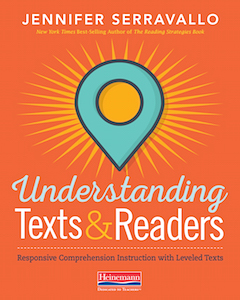Ideas to Match Kids Up with Stories They’ll Love
 By Jennifer Serravallo
By Jennifer Serravallo
Quick! Think about one of your favorite books of all time. Are you picturing it? Good. Now, think about what made it one of your all-time favorites.
Maybe it was the plot, so suspenseful that you just couldn’t put it down and you stayed up through the night to finish it. Maybe it was the characters – characters who still feel more like real life friends than figments of an author’s imagination. Or maybe it was the language the author used—beautiful and descriptive—that transported you to another time and place.
Possibly, it may have been the themes of the book that cut you to the core and forever changed the way you see the world. Or maybe it was a different reason entirely, such as reading it with friends in a book club and being able to discuss it along the way. Whatever the reason, that book has stayed with you.
Getting books they’ll love into kids’ hands
As teachers of reading, I believe our number one priority is getting books kids will love into their hands. And as we know, that task is incredibly hard at times! But if this year is going to be the year for our students to discover their all-time favorite books and have positive experiences reading them, then it can help to have some strategies in our back pockets. Here are 10!
1. Ask, “What kind of reader are you?” and then listen, really listen, when they tell you their answer. Listen as they tell you they are a reader who loves reading or doesn’t love reading. Then ask yourself, Why? See if you can figure out the conditions that made reading exciting or dreaded. Recreate the positive conditions this year and make sure to never repeat the conditions that diminished their identity as a reader.
2. Observe your students in and out of reading workshop. Listen as they settle in during the morning and unpack their backpacks. Watch them as they talk to friends and giggle at recess. Pay attention to what they do after school for fun. Notice the times of day they’re most engaged and the least engaged. All of this information is a window into interests that will let you know what kinds of topics and characters should fill the baskets of your classroom library!
3. Figure out which lenses your students read through. Is it plot? Character? Theme? Vocabulary and figurative language? Then help them do that work even deeper. For example, if they are “plot hungry” then help them see all the work there is to do related to plot and setting such as noticing all the important events, how they’re connected, and how the ending of the book links back to the main problem. In following their lead, you can help them see the depth of the work they are already approximating.
4. Buzz about books! Select a title that you think might intrigue your least engaged readers and then make a huge deal about it during class or Morning Meeting. Mention how you loved reading it, stayed up all night to finish it, and that you’re going to leave a few copies in a bin labeled Buzz Worthy if they care to check it out for themselves. Give value and social currency to the books you think will be a good match for your students and, before you know it, those books will fly off the shelves.
5. Read your own library! Consider starting with the most popular authors and series in your collection. Ask students to recommend books that you should read next. Make a pile of books next to your chair in the classroom that are “on deck” so students can catch a glimpse of your reading life.
6. Then, get to know what makes some books easier and some books harder for your readers. Familiarize yourself with the work that readers need to do in order to deepen their comprehension. You might even create a continuum of books at a range of levels so that you can reflect on what makes the work challenging for your students as they read harder texts.
7. Invite students into the work of goal-setting. You might have an idea of what they could work on as readers this year, but they probably have an idea too. Every few weeks, engage students in conversations about what they want to become better at and then find a series of strategies to help them get there.
8. Make reading social. Whether it’s being part of a book club where students decide what to read, by when, and what’s most important to discuss, or whether it’s having “reading buddies” they can check in with on a daily or weekly basis, students should be talking about their reading.
Books connect us and unite us. Students should use that shared experience of reading the same book or just talking about what they’re doing as readers in order to strengthen their identities as readers. And like most of us, students will probably find their next favorite title after having it recommended to them by a peer!
9. If a student wants to read a book that may be a bit challenging for her, support her! Students don’t live within reading levels, and there are many factors that impact what is “just right.” If a child is eager to read a text that at first appears a little too hard for her, find a way to teach into the text complexities, genre, vocabulary (or whatever may make it challenging) so that she has some scaffolds while reading it.
Consider matching the teaching methods you use as well—strategy lessons, guided reading groups, book clubs, or individual conferences, for example—so that you also find the setting and structure that enables the reader to deepen her comprehension in a book she may have once put down because it wasn’t “her level.”
10. Invite students to create the bins in your library, labeled with things they love: strong girl characters, books like Wimpy Kid, books that will gross you out. Ask your students if there are titles that are missing, people/identities/families that are underrepresented in the library, topics they want to read more about. This way, they are invested in their library, will know what books are on the shelves and where to find them – factors that are key in getting books into kids’ hands!
Fitting the strategies into your classroom
Maybe you shook your head a few times while reading this list, thinking, “Yes! I do that!” and maybe you found a new idea or two along the way. Just like we don’t ask kids to try a bunch of strategies all at once, I wouldn’t suggested that you should either. Perhaps try one new idea for a bit, then come back to the blog for another once that’s underway.
Please comment below with other top ideas/strategies to help kids find books and love the books once they are in their hands.
How to find time for individual student consultations?
See Jennifer’s article:
Effective 5-to-7 Minute Reading Conferences

Jennifer’s latest book, Teaching Reading Across the Day, Grades K-8: Methods and Structures for Engaging, Explicit Instruction (Corwin, 2024) promises to “help K–8 teachers plan and deliver lessons that ensure students meet both reading and content learning objectives in every subject all day long.”
Jen was a Senior Staff Developer at the Teachers College Reading and Writing Project and taught in Title I schools in NYC. She now leads the group Literacy Strategies Consulting, LLC. Follow her podcast To the Classroom and visit her website.





































I’m going to”buzz” about books, read my own library, and help students make reading goals. Thanks Jennifer!